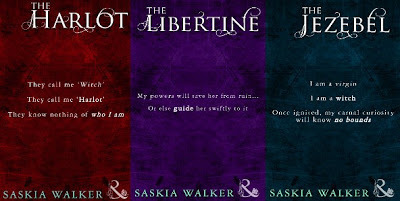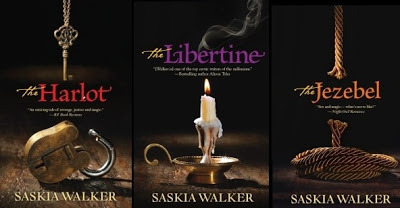Saskia Walker's Blog, page 133
April 2, 2013
Join me at the Smutketeers today
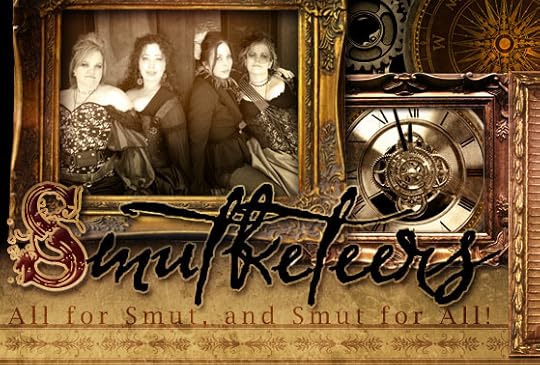
April 1, 2013
Publication day! Taskills books, here. there and everywhere
So let's start in the US, where today is publication day for print and digital formats of THE JEZEBEL! Yay! Print books should be in stores now and it's available at all the usual online retailers. It's also available in audio book.
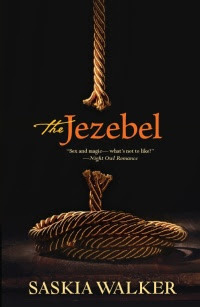 Once ignited, a witch’s carnal curiosity knows no bounds...
Once ignited, a witch’s carnal curiosity knows no bounds... On the run from her powerful benefactor whose unscrupulous interest in her magic has forced her to flee, Margaret Taskill has never needed a hero more. In order to gain passage from England to her homeland in Dundee, she plans to win over a rugged Scottish sea captain with the only currency she has: her virginity.
Maisie submits to Captain Roderick Cameron’s raw sexuality in search of protection, but as their initial attraction grows into obsessive desire, devastating powers are unleashed within her.
But the journey threatens to take a dangerous turn, forcing Maisie to keep close the secret truth about what she is, and keep the superstitious crew—unhappy at having a woman on board—at bay. With Maisie’s wealthy sponsor giving chase,
Roderick must stay one step ahead of the British Navy before her seductive magic causes a full-scale mutiny. He may believe he has full command of his ship, but he’s about to get much more than he bargained for.
Also now available Stateside is THE LIBERTINE in digital download.
Meanwhile, in the UK today it's the digital publication day for both THE LIBERTINE and THE JEZEBEL. You can download both books direct from Mills and Boon (soon, hopefully, when the site updates) or from Kindle and other retailers right now. No idea about print there as yet, so if you want these in print it might have to be via US import, whenever they become available. (not showing at Amazon as yet but I'll ask for info on these soon..)
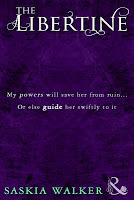

And in Australia today is print publication day for THE LIBERTINE. You can get it direct from Harlequin Australia or through Booktopia. I have no idea about digital there, but I assume it will follow.
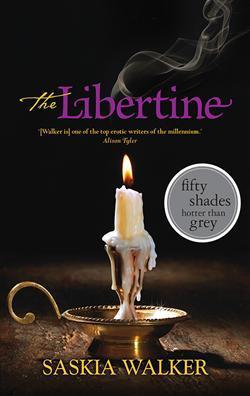
His powers could save her from ruin, or guide her swiftly to it.
Lennox Taskill is a dissolute rogue and powerful witch whose only loyalty is to his coven – his disdain for humanity sealed when his mother burnt at the stake. So when the wife of a wealthy landlord comes seeking his help, the beguiling Chloris Keavey unwittingly presents Lennox with his greatest opportunity for distraction . . . and retribution.
By failing to produce an heir, Chloris faces a terrible threat: being turned out by her heartless husband. Now she vows to get with child, even if it means surrendering her body – and soul – to Lennox’s seductive magic.
But with a witch-hunt brewing, Lennox and Chloris are soon risking everything for their forbidden nights of ecstasy . . . and to protect the secret that could cost them their lives.
Confused about the staggered dates/formats? Yes. Yes I am. ;o)) However, I shall attempt to stay on the ball as Norwegian, Swedish and Italian versions are due in various formats at various times over the summer. And you thought being an author was just about writing. ;)
If you pick up any of these, happy reading! There are some lovely reader comments coming in at Good Reads, thanks to everyone who has posted about the books.
March 31, 2013
Book contest - lots of goodies to win

March 28, 2013
Grab yourself (or a friend) a bargain read
UK readers can pick up the novel for 0.99p
US readers can pick it up for $1.51.
I don't know how long this promotion will last so grab it while you can!
I'll be updating availability of THE LIBERTINE and THE JEZEBEL in a couple of days – the release dates have been staggered in different countries so it’s a bit confusing (for me ! ;o) but I'll do a full rundown soon.
Hope you all have a lovely Easter.
March 20, 2013
Everybody...
― Alan Moore, V for Vendetta
Witches on Wednesdays - Law and Order in Lowlands Scotland
First, the local Bailiff (justice keeper/sheriff/magistrate) would be called. The accused individual would be incarcerated in the Tolbooth (ie in a jail cell) until trial. The term Tolbooth describes a town hall or guild hall where tolls would be paid and where a cell/s would house criminals. Witch Hunters (ie specialist magistrates) were called in to examine the accused for signs of the devil – marks or blemishes that indicated they were in league with devil. Often that was enough evidence, without a trial. Bad news if you had a birthmark, ay! The punishment under the law of King James was death, first by hanging and then the body was burned – just to be sure.
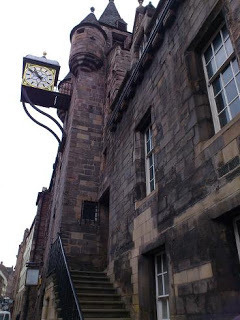 This is the Edinburgh Tollbooth on Cannongate. It was built in the late 1500's and the building now houses the People's Story Museum. This collection focuses on the everyday folk of Edinburgh over the centuries. Whilst small in comparison to the main museums in Edinburgh, it's a terrific collection and gives a real sense of life over the centuries. It also houses some items that were used to maintain law and order and an original cell to give visitors an idea what it was like in past times.
This is the Edinburgh Tollbooth on Cannongate. It was built in the late 1500's and the building now houses the People's Story Museum. This collection focuses on the everyday folk of Edinburgh over the centuries. Whilst small in comparison to the main museums in Edinburgh, it's a terrific collection and gives a real sense of life over the centuries. It also houses some items that were used to maintain law and order and an original cell to give visitors an idea what it was like in past times. 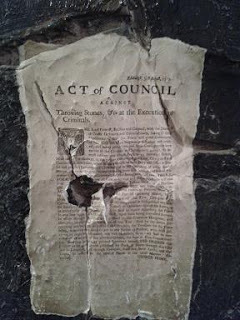 One of the first things you see on entering the museum is this official notice enforcing the law against throwing stones at the executioner and prisoners during an execution. Were the stone throwers in favour of the criminal, or aiding the deliverance of justice by showing their anger at the wrongdoer, or did they enjoy it as a show? A mixture, I suspect. It gives a sense of what the scene might have been like...
One of the first things you see on entering the museum is this official notice enforcing the law against throwing stones at the executioner and prisoners during an execution. Were the stone throwers in favour of the criminal, or aiding the deliverance of justice by showing their anger at the wrongdoer, or did they enjoy it as a show? A mixture, I suspect. It gives a sense of what the scene might have been like...In my reading on the Scottish witch trials I learned that in one instance the villagers stoned an accused woman then trampled her body to death beneath a wooden door, such was the fear and persecution surrounding "evil" witchcraft.These factual stories influenced the way I described the death of the Taskill's mother, which was also the moment when the three young siblings (Jessie, Lennox, and Maisie,) were torn apart. The scenes haunt all three of the Taskill Witches, inevitably, and it is Lennox above all who wants justice and battles injustice wherever he sees it--and he often gets a mite hoteheaded when he does.
From THE LIBERTINE:
Lennox swallowed down the shock he felt. She'd hidden herself very cleverly all through their time together. He realized that now. Hiding her shame, keeping the secret. Tracing the scars with his fingers he attempted to hold back the anger he felt when he felt pain there. It was as if he'd been thrashed, not her. It pumped into his fingertips, and it was not just this beating, but more. The anger he felt in response to the images that flared in his mind would not be kept in check—images of Chloris, and images from his childhood, pictures of his mother being stoned.
Chloris flinched at his touch on the raised skin.
That made his anger worsen. Forcing back the images of his own mother, lying on the ground stoned and bloody, frustration bit into him, his ire rising all the while. He voiced his opinion. "You wish to fall pregnant to a man who does that you?"
Her head lifted and she stared over her shoulder at him, dismayed.
"Answer me!" His indignation was making him unreasonable. He could see that fact reflected in her eyes, but he couldn't help being angry.
"It will not happen again," she snapped, "if I fall pregnant."
Lennox cursed aloud. "If you believe that then you are a fool."
Chloris jerked back in astonishment. It was she who looked angry now, the shame that had marked her expression quickly changing as she pulled her clothing into place, covering the scars she had so cleverly concealed during their relationship. "What do you know of me and my situation?"
Lennox felt that old anger and frustration, that which was borne of powerlessness, the mood that turned into white heat in his veins. He saw the men who stoned his mother almost to her last breath, then hauled her bloodied body upright so that she could take the final steps to the gallows where she would be hanged and burned. He'd cursed them all, until they bound and gagged him, but he had never forgotten the looks on their faces. Their fear twisted into glee, that ugly thing that turned them to animals. It disgusted him. "A man who does that to a woman will never change. There will be another cause for him to beat you, another day."
Below are some of the tools of the trade from the 1700s, including shackles and a neck brace. I was particularly freaked out by the pitch fork looking item on the left, which clicks around the neck of a criminal on the run. Yikes!
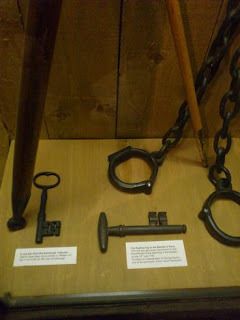
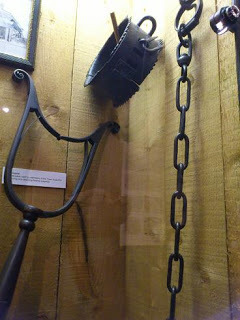
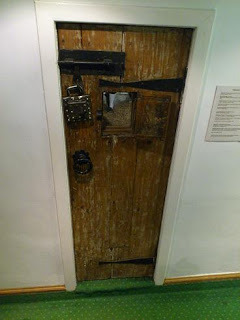 Part of an old cell in the People's Story Museum is maintained just as it was in the 1770s. The first time I saw this, it inspired me to include a cell scene in one my Taskill witch stories. That became chapter two of THE HARLOT, which is set in Dundee Tolbooth earlier in the 1700s. In the scene Jessie has been incarcerated on a charge of witchcraft, and awaits the arrival of the witch hunter who will examine her for the marks of the devil. She fears she will end her life as her mother did, but a rescuer is nearby...
Part of an old cell in the People's Story Museum is maintained just as it was in the 1770s. The first time I saw this, it inspired me to include a cell scene in one my Taskill witch stories. That became chapter two of THE HARLOT, which is set in Dundee Tolbooth earlier in the 1700s. In the scene Jessie has been incarcerated on a charge of witchcraft, and awaits the arrival of the witch hunter who will examine her for the marks of the devil. She fears she will end her life as her mother did, but a rescuer is nearby... Now, whilst the cell inspired the scene, I did take some liberties with my version, and I'm woman/author enough to admit it. ;o) In actuality these cells would have been tiny and airless, with multiple occupants, strong wooden doors and little if any light source. For the purposes of the novel, I described the cell as having iron bars, in order that Jessie Taskill could see her rescuer, Gregor Ramsay, by the candlelight that falls form a sconce in the corridor outside.
Here's a snippet from the scene in THE HARLOT:
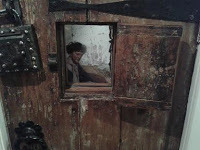
Rising to her feet, Jessie stalked into one corner where she stood with her arms folded across her chest. When the guard rattled his key and shoved it into the lock, she looked at it longingly. She could easily make it drop from his belt as he walked away, but she could not take the risk right at that moment, especially not with two of them watching her.
“Luck is on your side, Jessica Taskill,” the guard said. “The minister has risen from his bed to sit pray with you awhile.”
Jessie pressed her lips together while she battled the urge to tell them her beliefs did not match theirs. She managed to resist sparring out of bad humor, because she knew that if she kept quiet and acted penitent, he would be gone all the sooner.
The minister stepped into the cell and the guard locked the door behind him. The guard gestured with the candle he held aloft in his hand. “If she gives you any trouble you be sure to call out, Minister. I will hear you.”
Jessie looked at the Minister for the first time. He wore a wide brimmed hat and his head was lowered, which made it difficult to see him. Squinting in the gloom, she ducked her head a little, trying to catch sight of his face.
Then the guard set his candle in a sconce outside the cell. The light filtered in and she was able to properly assess the build of her caller. He was a large man, tall and bulky around the shoulders, unlike any minister she had ever seen. He wore the long somber cassock of the church, true enough, and it was buttoned from collar to hem, but she spied a fine ring snaked around his little finger, and expensive leather boots on his feet—silver-buckled boots.
“Thank you,” the minister replied. “I will say a few prayers with the sorry lass, and I’ll call you when I am ready to leave.” The guard nodded and lumbered off. The other man kept his head lowered until the sound of the guard’s footsteps scuffing along the hallway faded. What little candlelight fell into the cell from the hallway beyond was not aiding Jessie’s quest to study his face, and she leaned closer, her curiosity lifting by the moment. His jaw was solid and when he turned his head to listen to the guard’s retreat, she saw his mouth. Wide and passionate it was, and scarred from one corner to his cheekbone.
Recognition flared in her. “That guard is a fool,” she whispered. “No minister would wear fancy boots such as those.”
To close today's post I've included a snap of the museum's notes on the actual occupants represented here. So much inspiration in history! Next time I'll post about some of the factual stories around the witch trials in Scotland and England that inspired me.
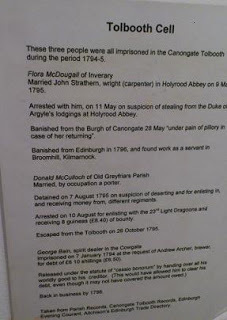
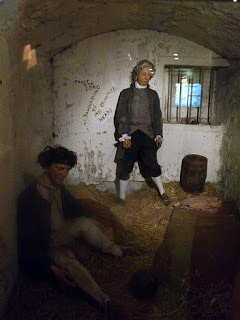
March 13, 2013
Witches on Wednesdays - travel and the landscape
As previously mentioned, the books are set in Lowlands Scotland. Whilst the Lowlands are not as wild and dramatic as the Highlands, the region is still marked by rugged coastline and rolling, often steep hills. It would have been rough terrain in the early 1700s. The only way to travel would have been by foot, by horse, or by horse and cart/carriage. There were no roads as we would understand it, at best there would have been tracks or lanes where the most direct and most frequently traveled routes had been worn in by travelers.
We have to surmise that for everyday folk, a rider on a horse would have been the quickest way to travel, because a horse pulling a cart or carriage on some of the roughest terrain would be slower. Wealthier people who could afford a team of horses – which they could purchase or hire – could move about more quickly. In my reading it became apparent that for those without wealth, hiring a horse and cart would have been out of their reach financially. How did everyday people move their goods about? If a person needed to move home, they often pulled their worldly goods on a wooden sledge-like device. It makes me tired just thinking about it!
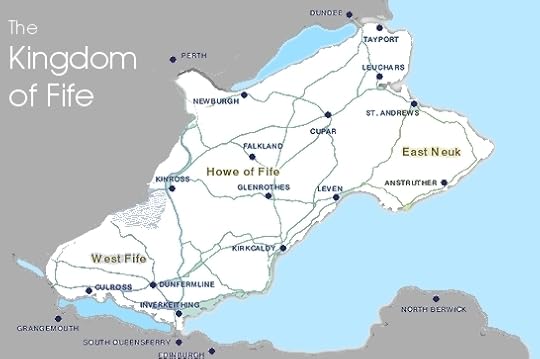 In books 1 and 2, THE HARLOT and THE LIBERTINE, the stories are mostly set in Fife, around St Andrews, along the coast to the East Neuk, with parts of the stories in Dundee and Edinburgh. One of the challenges of portraying a journey during a historic period is knowing how long it would take, given the terrain. As writers we strive to make this as accurate as possible because we don't want to pull anyone out of the story by suggesting an arduous journey was just a hop, skip and a jump away.
In books 1 and 2, THE HARLOT and THE LIBERTINE, the stories are mostly set in Fife, around St Andrews, along the coast to the East Neuk, with parts of the stories in Dundee and Edinburgh. One of the challenges of portraying a journey during a historic period is knowing how long it would take, given the terrain. As writers we strive to make this as accurate as possible because we don't want to pull anyone out of the story by suggesting an arduous journey was just a hop, skip and a jump away.On one of the writer's loops I am on I chatted about this problem and a fellow author had a great suggestion. Use the Google maps feature to assess the distance, but do it by pedestrian route. That way you're going to get a reasonably accurate idea of how long the journey might have taken in the past. I must admit it's something I never thought of doing for longer journeys, but it works and it proved really helpful. For example, a walking journey from St Andrews to Edinburgh would be about 51 miles and take around 17 hours on foot, with part of that journey by ferry across water. That way I estimated that by foot would take a couple of days, but I could just about have a character travel a similar route by carriage within one day - but only if they left at the very whip crack of dawn!
In my reading and my research in the museums, it became apparent how varied life could be even in one region. In the small villages around the coast, life frequently revolved around the daily catch. In the cities, it was markedly different. During the 18th-century Edinburgh was one of the most densely populated cities in Europe. If you visit Edinburgh today you can get a really good idea of this side of city life by visiting the People's Story Museum and the Museum of Edinburgh. The majority of people lived in rented rooms in tenements which were overcrowded, unsanitary, and a huge fire risk. When I learned about this side of city life, I decided that one of the darker characters in THE LIBERTINE would be a landlord, with his own burly henchman who collected rent from impoverished tenants! Lennox, the hero, uses fire in order to rescue the woman he loves. Such was the fear of fire getting out of control, that it's a powerful weapon when he chooses to use it! ;-)
The three Taskill siblings, Jessie, Maisie, and Lennox, were born in the Highlands and the ultimate goal of each character is to find each other again and to return to the Highlandswhere they would not be persecuted for witchcraft. In this snippet from THE LIBERTINE the heroine, Chloris, reflects on the differences between the city life that she has known in Edinburgh, and what might life might be like in the Highlands:
As the coachman guided the carriage toward the older part of the city, where the well-to-do merchants had their homes, they passed through the more cluttered and ramshackle parts of the town. Here the street vendors and traders sold their goods on either side of the narrow track left for the carriage, and noxious smells rose from the gully at either side of the street.
The coachman yelled from his perch, warning people out of his path. The man was weary, having been told to deliver Chloris and fast about it.
As she glanced out of the carriage Lennox's description of the Highlands whispered through her mind. Previously she had assumed it a lonely, barren place, only fit for sheep and wild Gaelic speakers, but Lennox's words had reformed her Lowlands' view of the heathen north. What he had described to her was a romantic place, a place where people could live and love without censure, a place where kin, clan, and coven were cherished. On that last fateful meeting he'd also told her that it would be hard, that they would have to build a new life together. It was a dream that would never be realized, an impossible dream. And now that she was forced back to the life she had known before, the yearning she had for Lennox and a life with him twisted like a knife in her chest.
The bitter irony of her situation made her eyes smart with unshed tears. She'd almost been ready to abandon her fears and leave with Lennox, and instead she had to return to the pitiful existence she'd had before, in order to protect him and his people.
The other town in THE LIBERTINE is St Andrews. St Andrews is the religious capital of Scotland, an ancient pilgrim site, and has a very different feeling to Edinburgh. As a visitor nowadays it feels more like a seaside market town, and that is reflected in the novel.
In the third book, THE JEZEBEL, I was able to explore the fastest way to travel during the early 1700s – by boat or ship. Even though travel by sea was fraught with its own set of problems, it was still much quicker than going overland. In THE JEZEBEL, Maisie Taskill has to travel from London to the Highlands of Scotland, to escape her keeper, and to reunite with her kin. Here's a snippet:
Inhaling the damp saltiness in the air, she breathed in gratefully. Out here on the ocean waves the elements wound their way into her, lighting her spirit. It called to her. Nature was more vivid out there and as the ship drifted over the waves, freed of land and the trappings of civilized life, it harkened her back to her memories of her young early life in the Highlands, where people lived much closer to the elements and to the seasons, moving within the rhythms of time and tide.
Maisie peered across the water at the distant shoreline. It was too far away for her to see the details but she saw the colors of the cliffs and the changing height of the coastline, the occasional bay marked by a blur of cottages. She tried to gauge how fast they were traveling. It was so hard to tell, but she knew it was faster than traveling on land by coach. That's why she had tried to find a ship to take her. Besides, the ship continued to travel through the night, aided by the tides and the wind in the sails, making progress where a coach and horses would have to rest at an inn overnight. A break in her journey like that might mean her master would find her.
A dark shiver went through her as she considered what Cyrus's reaction to her absence might have been. She tried not to think upon it—tried to convince herself that he would not pursue her. That was futile. He had invested many years in her, nurturing her craft, using it to further his progress in government matters.
The ship Maisie travels aboard is bound for Dundee and her original plan is travel onwards from there by horse/carriage and on foot to the Highlands – a long, gruelling journey. However, because the ship's captain comes to the rescue, the onward journey from Dundee to the Highlands is done by ship as well. In my reading, I found that quite common, the North Sea was teeming with ships and the coastal waters around Scotland– though treacherous - were busy with ships transporting goods.
If you are interested in the landscape of historic Scotland, Old Roads of Scotland is a great resource.
 I'll do a separate post about books on witchcraft that have been particularly interesting later on, but I want to recommend this book, A History of Everyday Life in Scotland, 1600 to 1800, as a really good primer for what life was like for ordinary people during the period. The book is set out as a series of academic papers and there's heaps of useful information there for historians and writers.
I'll do a separate post about books on witchcraft that have been particularly interesting later on, but I want to recommend this book, A History of Everyday Life in Scotland, 1600 to 1800, as a really good primer for what life was like for ordinary people during the period. The book is set out as a series of academic papers and there's heaps of useful information there for historians and writers. Next Wednesday I'll post little bit about law and order during the period. If you are reading the Taskill books and have any questions about the period or background details please post them on any of these Witches on Wednesday's blog posts and I'll do my best to answer them!
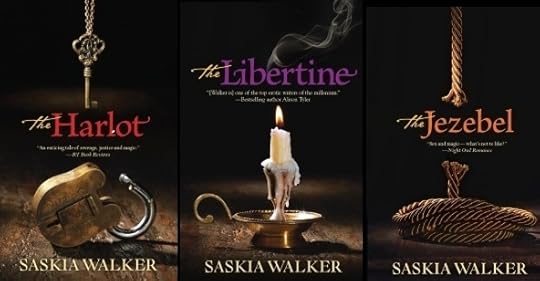
THE JEZEBEL - first look at Heroes and Heartbreakers
It's such an honour to see my book featured there! You can check out what Victoria has to say by clicking on the graphic below.

March 7, 2013
UK covers for Taskill Witches books 2 and 3 now in!
And the US versions for comparison - always intriguing to see how different countries package books to appeal to the audience they know.
It'll be interesting to see what the Scandinavian publishers do with The Taskill Witches later this year. They've done absolutely gorgeous covers for Tiffany Reisz's Original Sinners series. Yum.
March 6, 2013
Publishing in the new millenium
For someone like me, earning to help pay my bills from my back list being the most important. ;) Books that were no longer being pushed by a publisher can find new audiences when re-released, so if you have an option to try it, why not. But there are many other great reasons I admire independent publishing too.
It's creativity unleashed. I've been involved with publishing long enough to know that there are far too many great writers for the traditional publishing slots available, and that's the sad truth of it. When I hear an excited, keen author saying they want to write for X line, (where they'd obviously be a great fit and they have the talent to do so) I'm forced to look at how many books that line publishes a year, and how many of those might be repackaged books being put out for a second time. The maths can be very dispiriting indeed.
Another crucial aspect where self publishing is changing things is making books available that might not otherwise find a publisher because they are risky for a publisher -- edgy fiction, taboo sexuality, political or social books with controversial subject matter.
Here are just a couple of indie projects that show what can be achieved. First up, The Almond Tree, and secondly Excessica (who published some of my books before I was able to take on the task for myself) You can click on the graphics to find out more.

